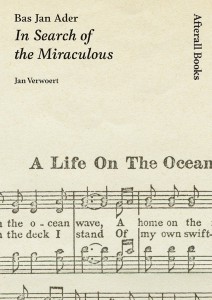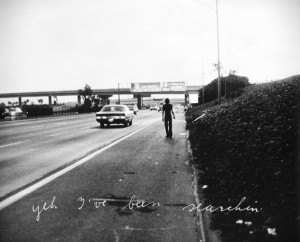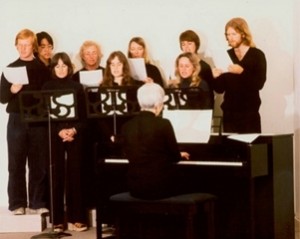In his tragically short career, the Dutch-born artist Bas Jan Ader has often been called a romantic conceptualist, a seeming contradiction considering the dry, analytical approach of his peers. Themes of noble tragedy, majestic triumph, even grand failure: these were concerns of the Romantics and the Abstract Expressionists—certainly not rigorous subject matter for conceptualist artists. Ader apparently held retrograde interests, but he certainly was no reactionary. He also paid dearly for his art.
In 1975 Ader set sail from Cape Cod, Massachusetts, in a one-person sailboat for the second part of his three-piece work, In Search of the Miraculous. He never completed his transatlantic voyage to Falmouth, England: radio contact was lost three weeks into the journey, and eight months later his boat was discovered partially submerged off the coast of Ireland. Ader’s body was never found.
Jan Verwoert discusses all these issues and more in Bas Jan Ader: In Search of the Miraculous, one of the first in Afterall Books’ planned series of one hundred short volumes dedicated to single works of influential contemporary art. This book’s publication also coincided with a retrospective of Ader’s work held in London and Rotterdam in 2006.
Briefly, In Search consists of photographs of a night walk in Los Angeles, where he lived and worked, and a chorus of friends and students singing old sea hymns; the ocean crossing; and another night walk in Amsterdam. In an engaging, cumulative argument that spans only forty-nine pages, the author emphasizes how this work investigates rather than embodies the very subject of the romantic, denying the common reading of the artist as a tragic figure, as his death at sea and the resulting cult of personality would have it. Through the sophisticated use of textual and mass-culture sources—outdated music (old pop songs, even older sea shanties) and obsolete methods of international travel (sailing instead of flying)—this work critically explores how existential thought and the romantic quest for the sublime might still be relevant.
Since Ader lived only to age thirty-three [and therefore had a relatively small oeuvre], Verwoert discusses a number of other works. Photographs and short films depicting the artist crying (I’m Too Sad to Tell You) and a simple written plea painted on a wall (Please Don’t Leave Me) present not the expression of the artist’s personal feelings but rather demonstrate how verbal and visual signs, taken out of a narrative context, become rhetorical devices serving an appellative function. At the same time, Verwoert argues, Ader never discounts, either cynically or ironically, the power of emotional address: “Rather than being products of subconscious causes,” as an expressionist canvas is, Ader’s artworks “are productive themselves in that they seek to trigger reactions and analogous feelings.” The artist’s search now becomes the viewer’s.
For many conceptual artists, the idea took precedence over form and content: ideas could be works of art in themselves. Implied in this was a rejection of Romanticism. Ader, though, understood these taboo subjects as abstract ideas and urgently tested their validity. Verwoert’s book helps us to understand better the artist’s conceptual project.
Originally published in the Art Book in February 2007.




